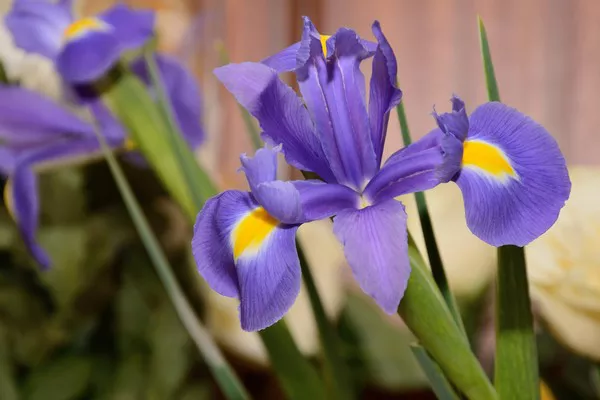Flowers have been cherished for their beauty and symbolic meanings across cultures and centuries. Among the vast array of flowers, the iris holds a special place, celebrated not only for its stunning appearance but also for the deep symbolism it embodies. In this article, we will explore the significance of the iris flower, including its history, cultural representations, and associations in different contexts.
1. The Beauty of the Iris Flower
The iris, scientifically known as Iris germanica, is a perennial flowering plant that belongs to the Iridaceae family. Renowned for its striking blooms, the iris comes in various hues, including shades of purple, blue, white, yellow, and even multi-colored varieties. The flower’s distinct appearance, characterized by three upright petals known as “standards” and three drooping petals called “falls,” adds to its allure.
2. The Ancient Roots of Iris Symbolism
The symbolism of the iris dates back to ancient times when it was associated with deities and myths. In Greek mythology, the iris was linked to the goddess Iris, who personified the rainbow and served as a messenger between the gods and humanity. The flower was believed to have been named after her, symbolizing the connection between heaven and earth.
In Ancient Egypt, the iris held significance as well. It was a symbol of renewal and protection, often depicted in art and used in religious ceremonies. The Egyptian pharaohs were also known to incorporate the iris in their burial rituals, considering it a symbol of their journey to the afterlife.
3. The Language of Flowers: Iris Meanings
During the Victorian era, a complex “language of flowers” emerged, where each flower conveyed specific sentiments and emotions. The iris, with its diverse colors and forms, came to represent various meanings, including:
Purple Iris: Symbolizing wisdom, admiration, and respect, the purple iris is often associated with compliments and admiration for someone’s achievements.
Blue Iris: Representing faith and hope, the blue iris conveys the message of trust and optimism in challenging situations.
White Iris: Signifying purity and innocence, the white iris is commonly used in weddings and symbolizes new beginnings and fresh starts.
Yellow Iris: Reflecting passion and positive energy, the yellow iris conveys enthusiasm and joy.
Multi-Colored Iris: A symbol of harmony and friendship, multi-colored irises are often given to convey appreciation for the recipient’s diverse qualities.
4. Iris Flower in Art and Culture
The iris flower has inspired artists and writers throughout history, leaving its mark on various forms of artistic expression. In paintings, the iris’s elegant and regal appearance has been captured by renowned artists like Vincent van Gogh, Claude Monet, and Georgia O’Keeffe. Its representation in art often intertwines with the meanings attributed to different colors, enriching the depth of the artwork.
In literature, the iris has been referenced in poems, novels, and myths, adding layers of symbolism to the narratives. Its significance in mythology and history has made it a compelling motif in storytelling, representing themes of communication, transition, and transformation.
5. Iris in Different Cultures
The iris flower’s symbolism extends beyond its ancient associations, with different cultures attributing unique meanings to the bloom:
Japanese Culture: In Japan, the iris, known as “shobu,” holds cultural significance and is associated with strength and courage. It is also used in the celebration of Children’s Day to represent the hope for children’s healthy growth and success.
Christianity: The iris flower has been linked to the Virgin Mary and is seen as a symbol of her purity and heavenly connection. As such, it is sometimes referred to as the “Sword Lily” or “Mary’s Sword.”
Fleur-de-lis: The fleur-de-lis, a stylized iris motif, holds strong symbolism in French history, representing royalty, purity, and faith. It has been used as a heraldic symbol, appearing on coats of arms, flags, and other emblems.
6. The Iris as a Symbol of Endurance and Resilience
Beyond its cultural and historical symbolism, the iris flower’s characteristics have made it a symbol of endurance and resilience. Its hardiness allows it to thrive in a wide range of environments, from wet marshes to dry hillsides, making it a symbol of adaptability and strength in the face of adversity. This quality has led the iris to be associated with qualities like courage, determination, and the ability to overcome challenges.
Conclusion
The iris flower’s symbolism is a testament to the profound impact flowers can have on human emotions, beliefs, and cultures. From ancient myths and religious associations to its diverse meanings in the language of flowers, the iris has captured the imagination of people across time and borders. Its beauty, combined with its rich symbolism, makes it a cherished flower that continues to inspire art, literature, and cultural expressions worldwide. Whether gifted as a token of admiration, used in religious ceremonies, or integrated into artistic masterpieces, the iris remains a timeless and meaningful emblem of human sentiments and aspirations.


